|
|
|
Sort Order |
|
|
|
Items / Page
|
|
|
|
|
|
|
| Srl | Item |
| 1 |
ID:
063393


|
|
|
| 2 |
ID:
129108
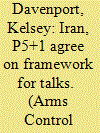

|
|
|
|
|
| Publication |
2014.
|
| Summary/Abstract |
After three days of talks in Vienna, Iran and six world powers agreed last month on a framework and timetable to guide the first four months of negotiations on a comprehensive deal on Iran's nuclear program. EU foreign policy chief Catherine Ashton, who leads the negotiating team for the six-country group known as the P5+1 (China, France, Germany, Russia, the United Kingdom, and the United States), said in a Feb. 20 statement that the parties had "identified all of the issues" to be addressed in the comprehensive agreement. An official who was briefed on the talks told Arms Control Today in a Feb. 20 e-mail that this is not a "written agenda" but an "understanding of the issues that must be covered." The official, who is from a P5+1 country, said that most of the discussions were on process but that "some substance was covered." The Feb. 18-20 meetings marked the resumption of political-level negotiations between Iran and the P5+1, following a Nov. 24 agreement on a plan of action, which laid out initial steps for each side to take and the broad parameters to guide negotiations on the comprehensive deal. (See ACT, December 2013.)
|
|
|
|
|
|
|
|
|
|
|
|
|
|
|
|
| 3 |
ID:
129533
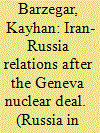

|
|
|
|
|
| Publication |
2014.
|
| Summary/Abstract |
In the triangle of Iran-U.S.-Russia relations, Russia is likely to strengthen its relations with Iran to equate the role and influence of its rival global power and Iran will attempt to stay in its independent track willing to expand relations to the one that accepts its regional role and global status.
The Geneva nuclear deal between Iran and the P5+1 and the possibility of rapprochement between Iran and the United States has provoked the debate that under the new circumstance Iran-Russia relations would not be as warm and expanded as in the past. But improved Iran-U.S. relations will not necessarily be at the expense of the traditional Iran-Russia ties; they may rather trigger some new potentials for these ties.
|
|
|
|
|
|
|
|
|
|
|
|
|
|
|
|
| 4 |
ID:
127857


|
|
|
|
|
| Publication |
2013.
|
| Summary/Abstract |
In February 1993, Russia and the United States signed an agreement on the disposition of highly enriched uranium (HEU) extracted from Russian nuclear weapons.[1] Under the terms of the deal, Russia undertook to down-blend 500 tons[2] of HEU, enough to build 20,000 nuclear warheads, over a 20-year period. The two sides agreed that the resulting low-enriched uranium (LEU) would be used as fuel by nuclear power plants in the United States, hence the informal name of the program, "Megatons to Megawatts."
In January 1994, Russia's Techsnab-export (Tenex) and the United States Enrichment Corporation (USEC), the state-run companies authorized by their respective governments to implement the deal, signed the contract. In the U.S. case, that meant that USEC was a supplier of enriched uranium to private utilities. According to assessments made at the time, the value of the entire program was expected to reach about $12 billion.
|
|
|
|
|
|
|
|
|
|
|
|
|
|
|
|
| 5 |
ID:
128058
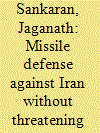

|
|
|
|
|
| Publication |
2013.
|
| Summary/Abstract |
All recent U.S. efforts after the conclusion of the 2010 New Strategic Arms Reduction Treaty (New START) to move ahead on bilateral nuclear arms reductions with Russia have stalled over Russian concerns regarding the capabilities of the European Phased Adaptive Approach, as the Obama administration's missile defense policy in Europe is formally known, and its effect on Russian nuclear retaliatory potential.Since the early stages of the phased adaptive approach, Russian officials have cited it as an obstacle to further nuclear arms reduction. Last March, however, U.S. Secretary of Defense Chuck Hagel announced a restructuring of the approach, canceling the planned implementation of its fourth phase, which had prompted the strongest Russian complaints.[1] The key feature of that phase was the deployment of the Standard Missile-3 (SM-3) IIB interceptors in Poland. The SM-3 IIB, with a planned velocity of 5.5 kilometers per second, would have had the ability to fly further and faster than any other missile in the system
|
|
|
|
|
|
|
|
|
|
|
|
|
|
|
|
| 6 |
ID:
132000
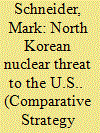

|
|
|
|
|
| Publication |
2014.
|
| Summary/Abstract |
A recent unclassified Defense Intelligence Agency (DIA) assessment stated: "DIA assesses with moderate confidence the North [Korea] currently has nuclear weapons capable of delivery by ballistic missiles." This conclusion is highly credible and not really new. North Korea was assessed to have nuclear weapons long before the actual (or at least detected) first test of these weapons in 2006. Building a nuclear weapon small enough to be carried by the relatively large payloads of North Korea's ballistic missiles is not a very difficult task today. In light of what is now known about the proliferation of a nuclear missile warhead from China to Pakistan and from Pakistan to North Korea, the North Korea defector reports about nuclear weapons development and the North Korean nuclear tests, the DIA conclusion may be an understatement. The North Korean nuclear stockpile may be significantly greater than what is usually assessed. This is of concern because the North Korean regime is the most brutal Stalinist dictatorship in the world. Moreover, while North Korea has long made occasional nuclear attack threats against the U.S. in the past, the scope, magnitude, and frequency of these threats vastly increased in 2013. Current U.S. policy, which downgrades the importance of nuclear deterrence and cuts missile defense, is not well suited to handle this threat.
|
|
|
|
|
|
|
|
|
|
|
|
|
|
|
|
| 7 |
ID:
090664


|
|
|
|
|
| Publication |
2009.
|
| Summary/Abstract |
This article focuses primarily on the nuclear relationship between the two countries with specific emphasis placed on the U.S.-Soviet Agreement on the Prevention of Nuclear War, signed in Washington between President Richard Nixon and General Secretary Leonid Brezhnev on June 22, 1973. Known by the British as "Operation Hullabaloo," and conducted in great secrecy, Britain's involvement was significantly greater than acknowledged at the time. Far from being bit players lurking in the wings of the Cold War, British officials were integral to the negotiations and largely responsible for drafting the treaty. But the dictates imposed in maintaining an exclusive bilateral relationship with Washington were often at variance with the need to develop a European security identity.
|
|
|
|
|
|
|
|
|
|
|
|
|
|
|
|
| 8 |
ID:
137574
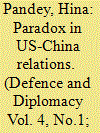

|
|
|
| 9 |
ID:
128079


|
|
|
|
|
| Publication |
2013.
|
| Summary/Abstract |
The U.S.-Russian agreement on Syria's chemical weapons is a recent, powerful reminder of the extraordinary value of arms control. An arduous process to find and destroy the chemical arsenal of Syrian President Bashar al-Assad lies ahead. Yet, it is made much simpler by the aggregation of expertise and baseline of protocols and procedures under the Chemical Weapons Convention (CWC), which was negotiated under President George H.W. Bush and ratified under President Bill Clinton. Imagine the difficulty of starting this effort without those assets. Why then is the United States degrading its capability to design, negotiate, and lead efforts to enforce agreements such as the CWC? In late 1999, the independent U.S. Arms Control and Disarmament Agency (ACDA) was folded into the Department of State, a process in which I was deeply involved as ACDA's last director. I had high hopes for the reorganization. While creating an institutional home in a larger, more powerful agency, the plan on which ACDA and the State Department had agreed, with congressional approval, preserved ACDA's two most irreplaceable assets-an independent voice for arms control and nonproliferation priorities at the highest levels of the government and protection of job security and career opportunities for the technical experts whose skills and insights were indispensable to success.
|
|
|
|
|
|
|
|
|
|
|
|
|
|
|
|
| 10 |
ID:
015075


|
|
|
|
|
| Publication |
June 1992.
|
| Description |
172-207
|
|
|
|
|
|
|
|
|
|
|
|
|
|
|
|
|
|
|
|
|